July 27, 2017 | Water in the West | Insights
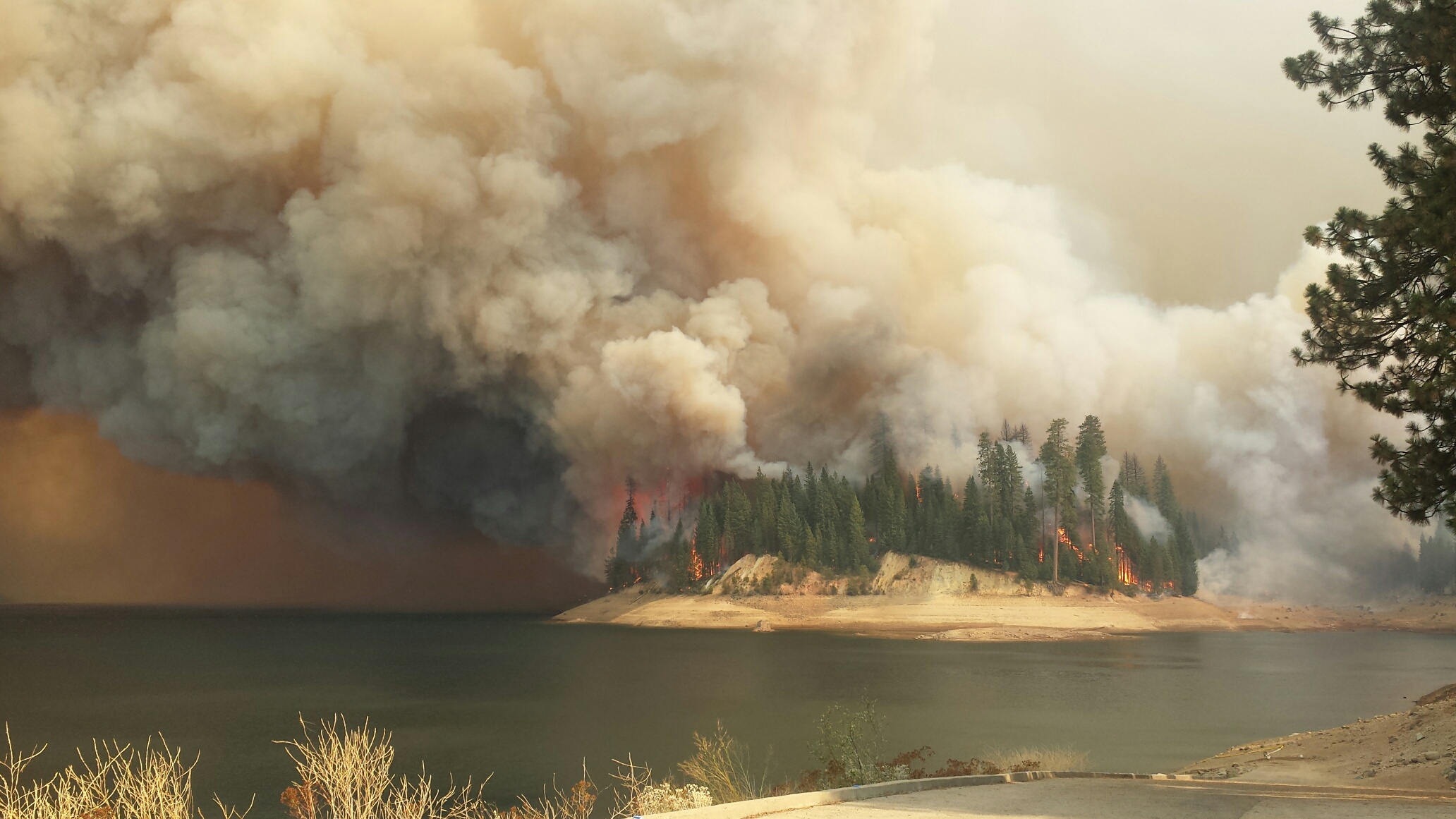
[Image credit: USFS Region 5 (CC BY 2.0)].
Fire in California's Sierra Nevada mountains
Hearkening back to Smokey the Bear, many of us tend to think that wildfire is "bad" — a disaster to be avoided. Such a narrative is enhanced by images of heroic firefighters, scorched hillsides, burned homes, evacuations, and appeal to the compellingly named disaster relief funds after major fires. Indeed, from 1987-2015, wildfire in California burned 16 million acres, and routinely incurred well over $200 million a year in emergency suppression costs, which represent only a portion of the total economic costs inflicted.
Talk to ecologists though, and you will soon hear the refrain that fire is a natural part of many landscapes, including California's Sierra Nevada. Fires also play a key role in renewal and growth, with some species like the Giant Sequoia depending on fire for regeneration. Not only are fires natural, but they used to be much more frequent. According to research at UC Berkeley, a more natural fire regime for mixed conifer forests in the Northern Sierra Nevada involves much shorter "fire return intervals" — where fire burns through your average piece of land every decade or two. Across the state's wide range of vegetation types, they estimate nearly 4.5 million acres burned in the average year prior to European settlement. By contrast, in more recent years, even the severe wildfire seasons have been under one million acres, with half a million more typical.
While it may be hard to imagine accepting this level of fire as you drive across California and into the Sierra, it's also important to consider that landscapes looked very different than they do today, and as a result, fires burned very differently. As highlighted by photographic evidence, our Sierra Nevada forests used to contain far fewer trees that were both bigger and more widely spaced. In these landscapes, low-level fires could burn through as a light disturbance, burning up litter and smaller vegetation, with occasional high severity patches serving as ecological niches for specific species. The large fire-adapted trees were resilient to fire around their trunks, and in the absence of small and medium sized "ladder fuels," the fire itself had much lower chance of reaching farther up large trees to become a more damaging "crown fire."
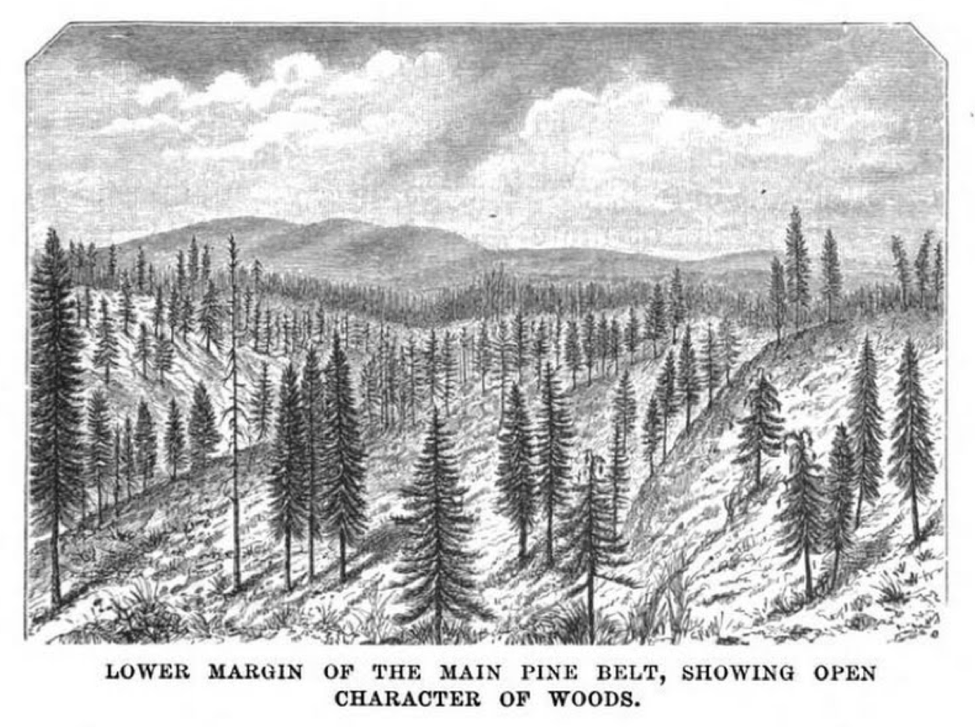
A depiction of the some of California’s historic landscape, from John Muir’s classic “The Mountains of California” published in 1896.
Of course, this is not the fire regime we have today, where large fires are becoming increasingly common, and the severity of fires has also worsened. This is a function of many factors, the first of which is a long history of fire suppression, which has resulted in a build-up of denser vegetation, in turn creating fires that are more difficult to control. The problem is exacerbated by droughts simultaneously creating dry fuel conditions and increasing susceptibility to beetle infestation – which will likely create large stores of fire-susceptible dead trees. Worse, from an ecological perspective at least, is that these fires tend to have a higher fraction of contiguous areas burned uniformly under high severity, unlike the predominantly low intensity fires of centuries past. While some high severity burning is "natural" on the landscape, large extents of high severity fire can lead to unnaturally denuded landscapes.
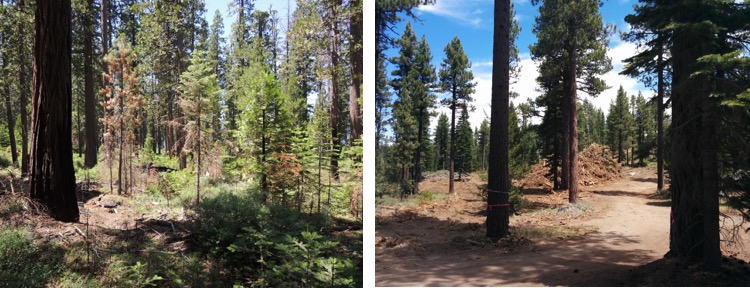
(Left) An unnaturally dense forest filled with ladder fuels on the South Fork of the American River. [Image credit: USFS Region 5 (CC BY 2.0)]. (Right) An in-progress fuels reduction treatment in the Tahoe National Forest near Fallen Leaf Lake, with debris pile still visible. [Image credit: Benjamin Bryant].
Forest restoration -- proactively reducing the density of trees and removing ladder fuels in long-suppressed forests -- is thought to benefit fire management as well as facilitate transition of the landscape to a more resilient state, especially when paired with prescribed burns. Given this, the U.S. Forest Service (USFS) and other forest managers are keenly interested in treating much greater areas of forests (including the Sierra Nevada) than are currently budgeted or approved to reduce wildfire risk and ideally promote other ecological outcomes, such as improving watershead health.
The relationship between watershed health, fire, and water
Why are we writing about fire on a Water in the West blog? To start, over half of California's water originates in the Sierra's (hence the keen interest in the state of mountain snowpack and what it portends for the rest of the year). The volume, timing, and quality of all this water is fundamentally determined by the state of the landscape on which it falls. Landscapes that have been thoroughly scorched by high severity wildfires don't have the same ability to capture, filter, and regulate water as a fire-adapted landscape. Rain events after a severe wildfire can lead to massive debris flows and "flashier" run-off, with the former potentially harming aquatic species and causing problems for hyrdropower and water utilities, and the latter leading to flooding concerns — or at least forcing some reservoirs to forgo electricity generation as they get more water than they can usually handle during the rainy season. In a fire-suppressed landscape, the high density of trees can negatively impact the supply of water reaching streams, as densely spaced smaller trees intercept and use more water than fewer large trees. The ability of a healthy forest to provide regular flowing and cleaner water to people relative to a degraded landscape is a classic example of "ecosystem services" — benefits people receive from nature.
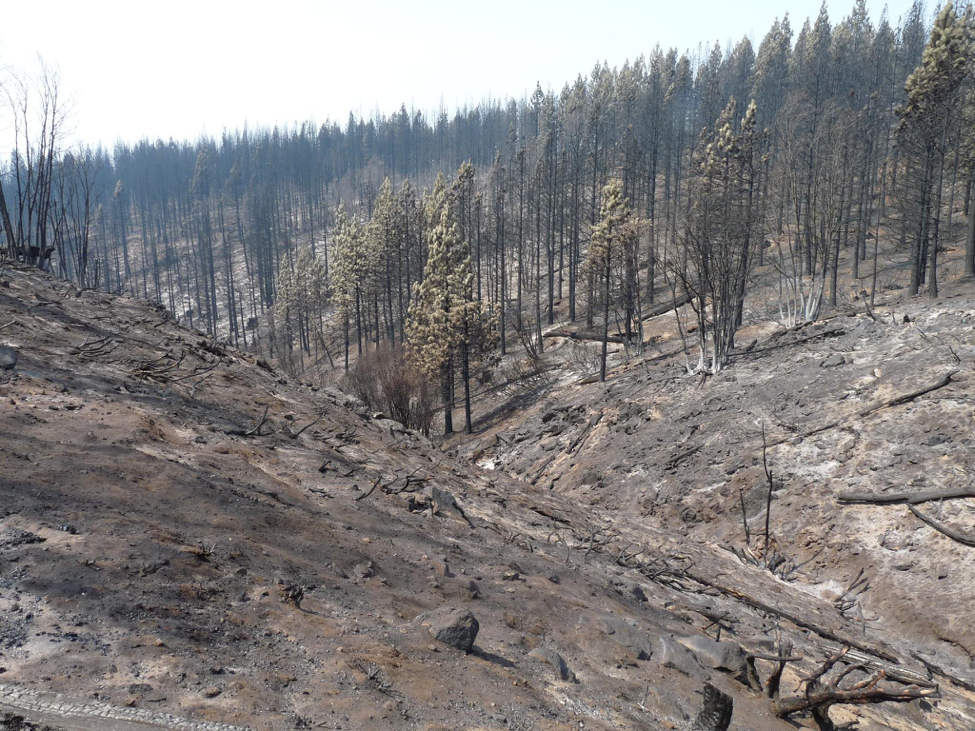
A burned subwatershed following the 2013 Rim fire. The heavy loss of transpiring vegetation dramatically affects how much and how fast water runs off, while the scorched surface is much more prone to erosion and carrying sediments into streams. [Image Credit: USDA on Flickr, CC BY 2.0].
The state of the vegetation can have even more nuanced effects on mountain hydrology over the year. One benefit of snowpack is that it stores water for release well after California has ended the rainy season, essentially acting as extra reservoir capacity, whose value increases the farther into the dry season it is released. Research has shown that vegetation is an important variable in how snow accumulates and melts. More snowpack can accumulate when it is not intercepted by tree needles (where it can melt before reaching the ground, or evaporate directly without reaching the ground at all) — but at the same time open snowpack also gets more direct sunlight and thus, can melt faster, so the net effect may vary. However, there may be such a thing as a “sweet spot” where a mix of tree patches and shaded open patches holds the best promise for total snowpack accumulation and delayed release. Even here, issues are very site specific, and further complicated by heat released from trees and rocks, and dirt, ash, and dust, which tend to heat up the snow causing it to melt faster.
So, does this mean we should be focusing on where and how much vegetation to remove as a way to solve California’s water woes? Absolutely not. But the potential for water-related co-benefits of forest restoration, which is something forest managers want to do anyway (for the sake of ecological integrity and fire management), means that a closer study and elucidation of these benefits may help tip the scales to make more beneficial restoration projects happen. It has the potential to to do this by unlocking additional funding opportunities from those who might benefit from multiple dimensions of an improved water supply. In other cases, a more complete accounting of impacts of restoration can demonstrate how restoration may lead to better outcomes for forest ecosystems, watersheds, and the people who depend on them.
What’s happening on the ground?
Recognizing both the potential value and the uncertainties involved, various for-profit, non-profit, and academic groups have been exploring ways to study the co-benefits of restoration, and in some cases, ways to secure additional funding to accelerate forest treatments, while learning from them as they are implemented.
On the funding front, Blue Forest Conservation, in partnership with Encourage Capital and other organizations, is working with US Forest Service to identify opportunities for private capital to fund restoration activities upfront (relieving pressure on a budget-strained USFS). The partnership is exploring several options for payment structures that reduce effective costs for USFS to get the restoration work done faster, and are intended to provide investors with a market rate return by monetizing anticipated co-benefits. For example, water utilities anticipated to benefit from protected water quality or increased water quantity may be willing to pay some portion of restoration cost based on measured outcomes, or as an upfront risk mitigation strategy. Although budget is not the only factor affecting the pace and scale of forest restoration, it is certainly a major one, with USFS forced to engage in “fire borrowing” wherein funds that could be used for restoration are instead used for immediate suppression needs. Success on this front could help remove a significant constraint.
As noted above, actors in this space are keenly aware there is still uncertainty about the site-specific impacts of restoration treatments on water outcomes (as well as other potential co-benefits, like climate regulation through carbon storage) -- as such, they are approaching their work as an opportunity for learning and advancing science. For example on the biophysical front, the California chapter of The Nature Conservancy (TNC) has partnered with the American River Conservancy, the Placer County Water Agency (PCWA), and the Tahoe National Forest to implement forest treatments in the watershed above the French Meadows reservoir on the Middle Fork of American River. As part of this process, TNC scientists are working with private contractors to model potential fire behavior with and without forest thinning and burning treatements; and they are working with scientists at Cal Poly, San Luis Obispo and the Sierra Nevada Research Institute (SNRI) to emprically measure changes in soil moisture and streamflow as a result of meadow and forest restoration. Blue Forest Conservation is also coordinating with SNRI and others to evaluate the hydrologic impact of pilot projects that come to fruition.
At the same time, Stanford researchers at Water in the West and the Natural Capital Project are working with TNC, PCWA, and Blue Forest Conservation to assess how well we can predict changes in hydrology, and also how well those changes in hydrology translate to financial benefits for downstream beneficiaries — especially when the California’s complex water infrastructure and policy environment is taken into account. For example, in the French Meadows project, we are modeling what different potential hydrologic outcomes might mean for their “bottom line” in terms of hydropower generation, while at the same time examining their ability to enhance river flows for aquatic species. In the long run, these estimates can be compared to the measurements undertaken by the SNRI team to better assess our ability to predict investment returns. In the short run they can help focus science and investment efforts on the co-benefit streams likely to be of the largest magnitude.
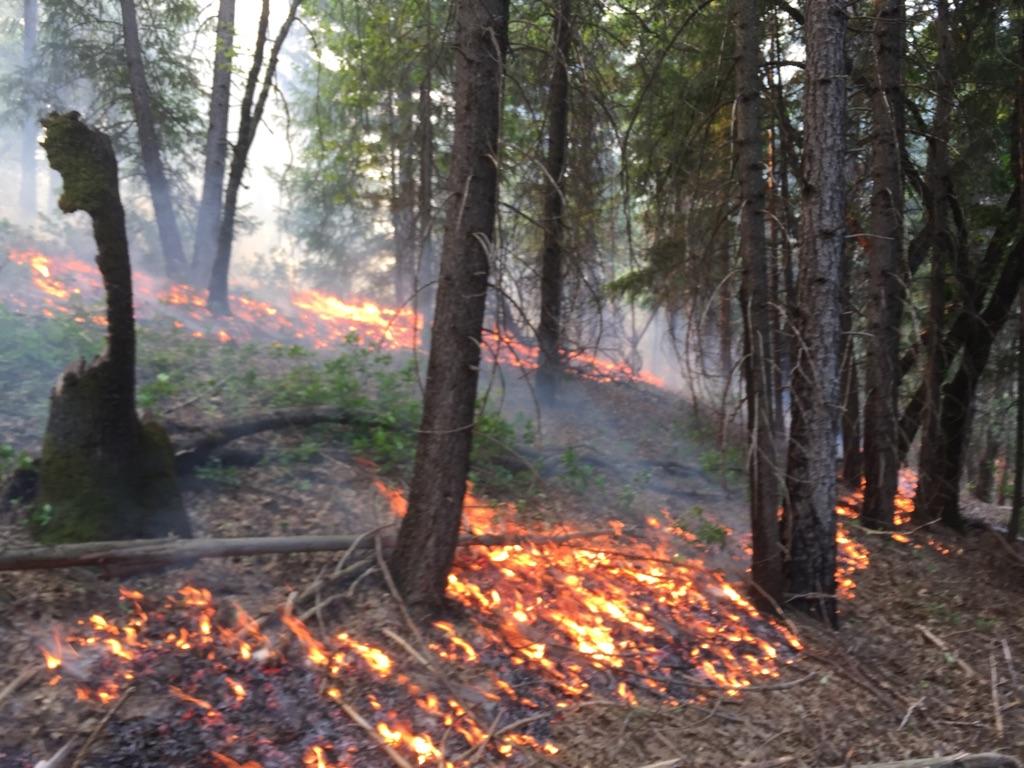
An example of a prescribed burn. [Image credit: USFS Region 5 (CC BY 2.0)].
In general, evaluating forest restoration projects as private or social investments faces several challenges above and beyond determining whether they make sense overall. One critical factor is that time matters in investments. It matters financially because returns farther off in the future are discounted (both by planners and investors). It also matters in terms of fire and water behavior, because the effect of treatment on fire and water outcomes is a function of the state of vegetation -- as vegetation regrows the treatment effect will diminish. New growth depends on whether the area sees a fire, and even what the weather is in the years following treatment. When evaluated on a large scale these differences might average out, but the “return on investment” for water quantity and quality improvement through forest restoration can have high variability within a specific watershed. These are surmountable analytic challenges and do not necessarily affect the expected value of these investments, but rather change the types of analyses that may be needed to resonate with investors. For example, a compelling case for investment may be made by firmly establishing lower bounds across many different potential benefits.
Ultimately, forest restoration can affect water supplies (as well as other ecosystem services such as carbon storage and sequestration and opportunities for recreation), but understanding how they do so and using that understanding to inform decisions is far from simple. While the overall balance of evidence suggests that restoring forests achieves many of its desired objectives, the nature and distribution of impacts will always remain somewhat uncertain, and may differ depending on where and what activities are conducted. For example, the best place for rapid gains in wildfire management and reducing risk to communities may not be the best place to provide returns for biodiversity and other ecosystem services. The best places for carbon may not be the best places for water, and the best place for improving water quality for anglers and fish may not be the best place for improving water yield to utilities. Yet these tensions and uncertainties are not cause for inaction. Rather, they highlight the need for action supported by transparent and usable science attuned to the relevant decision processes. Fires will continue to burn the landscape, and do so in a way that is partially determined by decisions in the public and private sector about where and how to spend money on that landscape. The more we can illuminate the consequences of these actions for communities and companies, the better grounding we will have to shape those decisions in processes that benefit all.
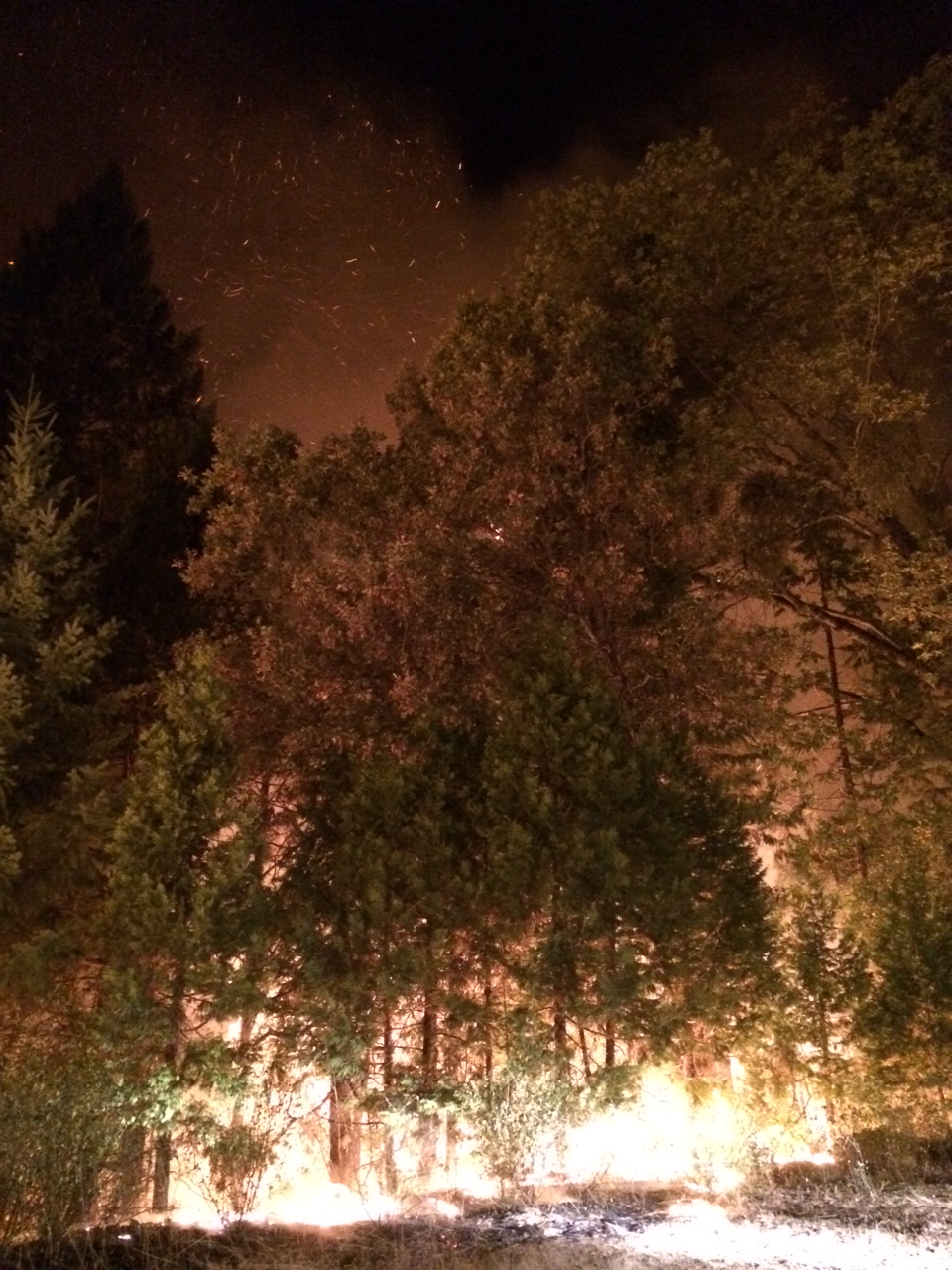
[Image credit: USFS Region 5 (CC BY 2.0)].
Benjamin Bryant is a postdoctoral scholar with Water in the West and the Natural Capital Project at Stanford. Phil Saksa is a research consultant working with Water in the West as well as Blue Forest Conservation. This blog also benefited from helpful comments from several colleagues and collaborators.

![[Woods Logo]](/sites/default/files/logos/footer-logo-woods.png)
![[Bill Lane Center Logo]](/sites/default/files/logos/footer-logo-billlane.png)